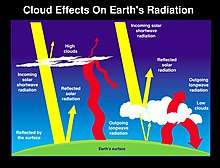Cloud albedo

Cloud albedo is a measure of the albedo of a cloud. Higher values indicate that a cloud reflects a larger amount of solar radiation and transmits a smaller amount of radiation. Cloud albedo depends on the total mass of water, the size and shape of the droplets or particles and their distribution in space.[1][2]
Cloud albedo, along with the greenhouse effect of clouds, strongly influence the Earth's energy budget.[3]
Thick clouds (such as stratocumulus) reflect a large amount of incoming solar radiation, meaning they have a high albedo. Thin clouds (such as Cirrus) tend to transmit most solar radiation, so have low albedo.[4][5]
What can change cloud albedo?
Liquid Water Path (LWP)
Studies have shown that cloud liquid water path varies with changing cloud droplet size, which may alter the behavior of clouds and their albedo.[6] The variations of the albedo of typical clouds in the atmosphere are dominated by the column amount of liquid water and ice in the cloud.[2] Cloud albedo varies from less than 10% to more than 90% and depends on drop sizes, liquid water or ice content, thickness of the cloud, and the sun's zenith angle. The smaller the drops and the greater the liquid water content, the greater the cloud albedo, if all other factors are the same.
The Twomey Effect (Aerosol Indirect Effect)
Addition of cloud nuclei by pollution can lead to an increase in solar radiation reflected by clouds.[7] Increasing aerosol concentration and aerosol density increases cloud droplet concentration, decreases cloud droplet size, and increases cloud albedo.[2][6] In macrophysically identical clouds, a cloud with few larger drops will have a lower albedo than a cloud with more smaller drops.[8]
Zenith Angle
The cloud albedo increases with the total water content or depth of the cloud and with the solar zenith angle.[2] The variation of albedo with zenith angle is most rapid when the sun is near the horizon, and least when the sun is overhead. Absorption of solar radiation by plane-parallel clouds decreases with increasing zenith angle because radiation that is reflected to space at the higher zenith angles penetrates less deeply into the cloud and is therefore less likely to be absorbed.[2]
References
- ↑ "CLOUD ALBEDO EFFECT". www.theweatherprediction.com. Retrieved 2017-05-30.
- 1 2 3 4 5 Hartmann, Dennis. Global Physical Climatology. Australia: ELSEVIER. pp. 76–78. ISBN 978-0-12-328531-7.
- ↑ Steve, Graham, (1999-03-01). "Clouds & Radiation Fact Sheet : Feature Articles". earthobservatory.nasa.gov. Retrieved 2017-05-30.
- ↑ "EO Library: Clouds & Radiation Fact Sheet". NASA. Retrieved 2008-10-15.
- ↑ http://www.cgd.ucar.edu/cms/cchen/Latham_et_al_2008.pdf%5Bpermanent+dead+link%5D
- 1 2 Han, Qingyuan; Rossow, William B.; Chou, Joyce; Welch, Ronald M. (1998-07-01). "Global Survey of the Relationships of Cloud Albedo and Liquid Water Path with Droplet Size Using ISCCP". Journal of Climate. 11 (7): 1516–1528. doi:10.1175/1520-0442(1998)0112.0.CO;2. ISSN 0894-8755.
- ↑ Twomey, S. (May 1974). "Pollution and the Planetary Albedo". Pollution and Planetary Albedo: 1.
- ↑ Wood, Rob. "The Twomey Effect" (PDF). atmos.washington.edu. Retrieved 28 May 2017.